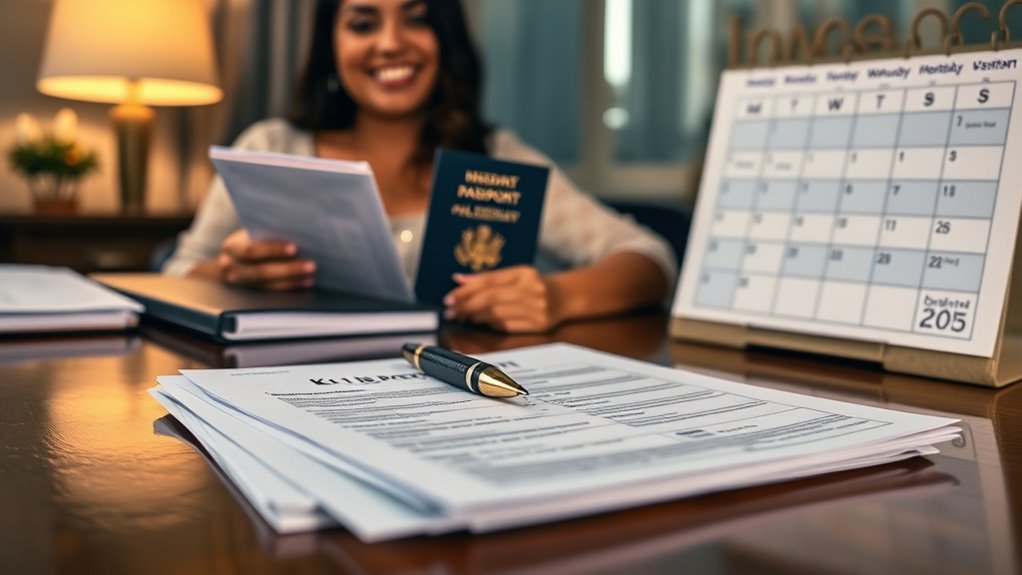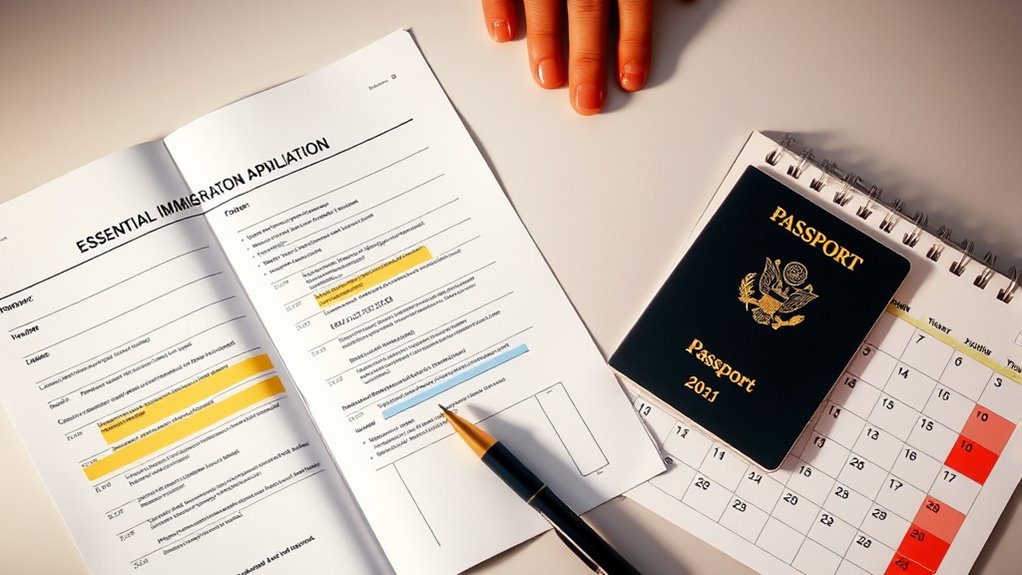To handle immigration paperwork for your Filipina fiancée, start by understanding the K-1 visa requirements. You’ll need to file Form I-129F and prove you’ve met in person within the last two years. Gather her birth certificate, passport, police clearance certificates, and evidence of your relationship. Prepare for the application process, including the visa interview, by compiling necessary documents and practicing your responses. There’s much more to guarantee a smooth process, so keep going to learn additional important steps!
Key Takeaways
- File Form I-129F with USCIS, ensuring all required documentation is included for your Filipina fiancée’s K-1 visa application.
- Provide evidence of your genuine relationship, including photos, communication records, and proof of in-person meetings within the last two years.
- Gather necessary documents such as her birth certificate, valid passport, and police clearance certificates from countries she has lived in.
- Prepare for the visa interview by reviewing common questions and ensuring all application details are consistent and truthful.
- After approval, complete the DS-160 application, schedule a medical examination, and gather essential documents for her embassy interview.
Understanding K-1 Visa Requirements

When you’re considering bringing your Filipina fiancée to the U.S. through a K-1 visa, it’s vital to understand the specific requirements involved.
First, you must file Form I-129F, the Petition for Alien Fiancé(e), with USCIS. You’ll need to prove you’ve met in person within the last two years, unless you qualify for an exception.
It’s essential to guarantee both of you’re legally free to marry and that you plan to wed within 90 days of her arrival. The K-1 visa is strictly for marriage, so keep that in mind.
Additionally, you’ll have to provide evidence of your genuine relationship and demonstrate your financial ability to support her once she arrives.
Gathering Necessary Documentation

As you prepare to bring your Filipina fiancée to the U.S., gathering the necessary documentation is essential for a smooth application process. Start with her birth certificate and valid passport.
Next, obtain police clearance certificates from her home country and any other country where she lived for over six months since age 16. If applicable, collect any marriage-related documents like divorce decrees or annulment records.
You’ll also need to provide an Affidavit of Support (Form I-134) and your most recent tax returns to demonstrate financial stability.
Gather evidence of your relationship, including communication records, photos, and travel documents.
Finally, prepare for her medical examination with the required vaccinations and medical report before submitting your application package.
Navigating the Application Process Timeline

After gathering the necessary documentation, it’s time to navigate the application process timeline for your Filipina fiancée’s K-1 visa.
The entire process generally takes about 4-7 months. Start by filing Form I-129F with USCIS, which usually takes 4-6 months for approval.
Once approved, your case moves to the National Visa Center (NVC) for about 4-6 weeks before it’s sent to the U.S. Embassy or Consulate.
Keep in mind that any requests for additional documents can delay the timeline. Aim to file during off-peak times to avoid processing backlogs.
Stay organized and maintain communication with USCIS and NVC to monitor your application status and guarantee a smooth experience throughout the process. Additionally, understanding the reasons for the breakup can help you approach the situation with empathy and patience if any issues arise during the waiting period.
Preparing for the Visa Interview

Preparing for the visa interview can feel challenging, but with the right approach, you can navigate it successfully. Start by researching common interview questions, focusing on how you met, your engagement, and future plans together.
Gather necessary documents like the I-129F application, DS-160 confirmation, and proof of your genuine relationship, such as photos and communication records. Review your application details thoroughly to guarantee your answers are consistent.
Practice your responses to maintain honesty and avoid guessing—it’s okay to say, “I don’t know.” Expect personal questions about your relationship, and be prepared to share specific examples that demonstrate your commitment.
This preparation will help you present your case confidently and sincerely.
Addressing Financial Support Criteria

When addressing financial support criteria for your Filipina fiancée’s K-1 visa application, understanding the minimum income requirements is vital.
For a household of two, you need to demonstrate an annual income of at least $20,440 as of 2025. If you live in Alaska or Hawaii, those numbers increase to $24,640 and $22,680, respectively.
You’ll need to show stable earnings through recent tax returns, pay stubs, and bank statements. If your income falls short, consider finding a joint sponsor to help meet the requirements.
To ensure financial eligibility, provide recent tax returns, pay stubs, and bank statements; consider a joint sponsor if needed.
Remember, both you and the joint sponsor must prove your ability to financially support her, ensuring she won’t become a public charge.
Keeping your financial documentation up-to-date is essential for a smooth application process.
Demonstrating a Genuine Relationship

To successfully demonstrate a genuine relationship with your Filipina fiancée, you’ll need to provide compelling evidence that highlights the depth and authenticity of your connection.
Start by gathering records of your ongoing communication, such as emails, text messages, and phone bills. A timeline of communication dates can emphasize your consistent engagement.
Next, submit photographs that capture both special moments and everyday life together, along with context to enhance their significance.
Travel itineraries, flight tickets, and hotel bookings will show your joint adventures.
Don’t forget witness statements from friends, family, and colleagues who can vouch for your relationship.
Finally, create a relationship timeline highlighting key dates, milestones, and shared goals to strengthen your case further.
Post-Approval Steps for the K-1 Visa

After your K-1 visa petition is approved, several important steps must be taken to move forward with your Filipina fiancée’s immigration process.
First, the National Visa Center (NVC) will assign a case number and send your case to the U.S. embassy or consulate.
The National Visa Center will assign a case number and forward your petition to the U.S. embassy or consulate.
Your fiancée needs to complete the DS-160 application and print the confirmation page. She should also schedule a medical examination with an approved doctor and gather essential documents, such as her passport and birth certificate.
Additionally, if required, obtain a police clearance certificate.
Finally, be prepared for her interview at the embassy or consulate, where officials will assess her eligibility and the authenticity of your relationship.
Legal Considerations and Expert Advice

Maneuvering the legal landscape of immigration paperwork can feel overwhelming, but understanding the key considerations helps streamline the process for you and your Filipina fiancée.
U.S. immigration laws govern the K-1 visa, specifically designed for foreign fiancées to enter the country for marriage. Ascertain both of you’re legally free to marry and submit the I-129F form to initiate the process.
Collect essential documentation, including personal identification, evidence of your relationship, and financial sponsorship papers. Consulting an immigration attorney is wise to navigate complexities and avoid pitfalls.
Stay informed about processing timelines, as they can vary. Utilize online resources for support and updates from USCIS, ensuring you’re prepared every step of the way.
Frequently Asked Questions
Can I Expedite the K-1 Visa Process?
Yes, you can expedite the K-1 visa process under urgent circumstances, like medical emergencies.
First, make sure your case is documentarily qualified and gather necessary documentation to support your request. You’ll need to file with USCIS, clearly outlining the reasons for expediting.
It’s also possible to reach out to a congressional representative to highlight your situation.
Just remember, approval isn’t guaranteed, and USCIS evaluates each request on a case-by-case basis.
What Should I Do if My Application Is Denied?
Receiving a denial can feel like the sky’s falling, but don’t lose hope.
First, review the denial letter for specific reasons. Make sure you’ve submitted all required documents and check for any inconsistencies.
Gather stronger evidence of your relationship, like photos and travel itineraries, and consult an immigration attorney for expert advice.
They can help you navigate this process and enhance your chances for a successful reapplication or appeal.
How Can I Track My Application Status?
To track your application status, start by using the USCIS online tool with your receipt number.
It gives you updates on your Form I-129F petition.
After approval, switch to the U.S. Department of State’s CEAC to check your visa application status.
Don’t forget to keep your contact information accurate on all forms, and check back regularly to catch any updates or potential delays in processing times.
Are There Any Travel Restrictions During the Application Process?
While managing the application process, you might feel like you’re walking a tightrope.
Fortunately, there aren’t strict travel restrictions for your fiancée during this time. However, if she wants to visit the U.S. beforehand, she’ll need a tourist visa.
Just keep in mind, entering on a tourist visa and later applying for a K-1 could complicate matters.
Planning her travels carefully guarantees everything stays on track for your future together.
What if My Fiancée Has Children?
If your fiancée has children, you’ll need to include them in the immigration process. Each child under 21 and unmarried can apply for a K-2 visa.
You’ll list them on Form I-129F and submit separate applications for each child. Make sure to gather necessary documentation, like birth certificates.
After entering the U.S., they can apply for a Green Card. Keep in mind the financial support and travel arrangements for everyone involved.
Conclusion
Steering through immigration paperwork for your Filipina fiancée might seem overwhelming, but remember, every step you take brings you closer to your future together. Coincidentally, while you’re gathering documents and preparing for that all-important interview, you’re also building memories that strengthen your bond. Embrace this journey, and don’t hesitate to seek expert advice when needed. With patience and determination, you’ll turn the complexity of paperwork into a beautiful chapter of your love story.









